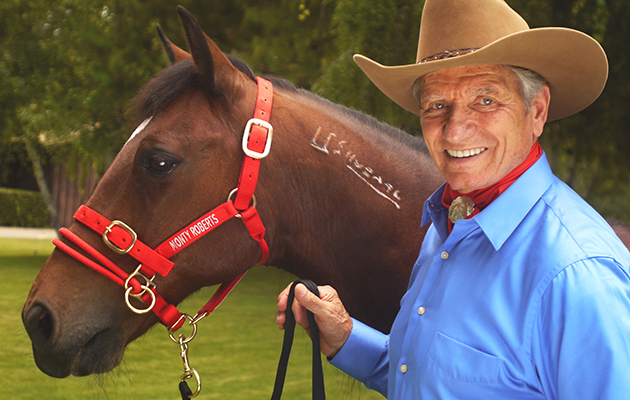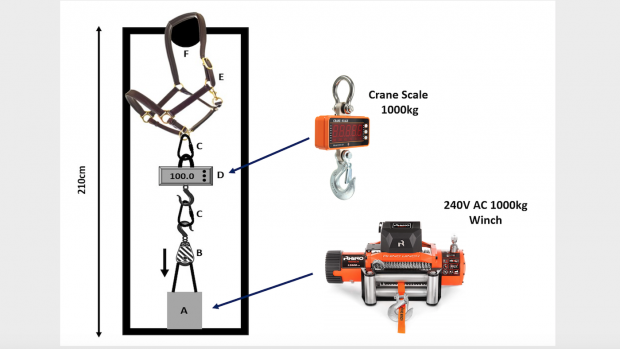Do you have a strong or bolshy horse that misbehaves when you lead him in from the field? Or do you need a bit of extra help while loading or long-reining a nappy or nervous type? The Dually training halter, designed by Monty Roberts, can be used in a number of different situations from leading, loading and long-reining
What is the Dually halter?
The Dually headcollar is a patented training halter, designed by Monty Roberts, which effectively rewards horses for acting in partnership with its handler.
It’s very versatile as it can be used as a standard or training halter. It’s fully adjustable and comes with an instructed video and booklet to explain its fitting and use. The Dually is used as a schooling aid (as an alternative to a bridle, a chifney, a lunge cavesson, a flat halter, rope halter with knots or a halter with a chain over the nose). The halters are colour coded and red is the smallest size.
How does the Dually halter works?
It works on the basis of pressure and release and works more effectively than simply wrapping the lead rope around the horse’s nose, as it will release pressure very quickly allowing the handler to be more precise with their training signals.
“The ring on the sliding noseband is positioned high on the nose, not low, so it doesn’t put pressure on the very sensitive parts of the horse’s head,” says Kelly Marks, of Intelligent Horsemanship, the UK’s only supplier of the Dually halter.
“The pressure is only applied when the horse backs away from you or moves out of the ‘comfort zone’ (this being within a respectable distance from you). As soon as they move back, away, or stop, the pressure is immediately applied and their instinctive reaction is to move out of the pressure zone and back towards you. When they do this they are instantly rewarded as the pressure releases straight away.”
What impact does it has on the horse?
“The reason you’re using the Dually is because it won’t damage or desensitise your horse’s mouth,” says Kelly. “It doesn’t dig in anywhere or work on very sensitive areas of the horse’s face — it doesn’t use excessive poll pressure and fitted correctly it won’t slip around the horse’s face, so you gain more accuracy and control of the horse with less compression than most other options.”
How is the Dually halter fitted?
“If you don’t take the time to fit the Dually correctly, then it won’t work the way it’s intended to,” says Kelly. “Fitted correctly is the key phrase here. It’s best to take a little extra time getting the fit exactly right if you really want the Dually to give you good results with your horse.
“It might take a little while to get used to it needing to go a little higher than you would fit a standard headcollar. This is because the Dually halter is not intended to work on the soft part of the nose.”
1. “The upper noseband part should nearly reach the bottom of the horse’s cheekbone to be in the correct position,” says Kelly. “When fitting it this high, it’s sometimes necessary to undo not only the band across the nose, but also the band underneath the chin. Fit the Dually high enough by adjusting the headpiece and then do the two lower bands up to secure the Dually firmly, but not tightly, on the horse’s face.”
2. “A rough guide would be to ensure you can place two fingers in any section of the Dually and the horse can relax his jaw. You still need to make sure the Dually won’t slip around on the horse’s eye if pressure is applied on the line from any angle.”
3. “If you’re worried your horse or pony is very sensitive you may wish to purchase a natural sheepskin guard to go over the acting part of the noseband. This is generally not necessary but horses that are long lined off the Dually with strong changes of direction could conceivably get rubbed and so this could be an option,” says Kelly.
Things to remember….
1. Never tie a horse up using the schooling ring of the Dually halter. “This is because if the horse pulls back the schooling ring will continue to tighten across his face and could potentially damage it,” says Kelly.
2. Horses should never be loose in a stable or field with a Dually in case they get caught up in anything. “If you wish to travel your horse in a Dually as many people do, just ensure you tie up to the correct (non schooling) ring and that there’s nothing in the horsebox that the other rings could get caught up in,” explains Kelly.
3. “If your horse is going to eat hay on his journey, it’s advisable to loosen the Dually off under the chin a few holes so he can move his jaw comfortably,” adds Kelly.
Dually halter: the verdict
Showing producer Simon Charlesworth credits the Dually to fulfilling his dream of taking his first supreme title at Horse of the Year Show (HOYS) with Pearly King.
The top class large hack, known as Elvis at home, had initial problems with noise and standing still. After a day with Monty Roberts and the acquaintance of the Dually halter, Elvis went on to achieve numerous successes in the show ring.
“I used the Dually to teach him to stand still and deal with noise while standing,” says Simon. “Without it and the time spent with Monty, I don’t think he would have ever gone on to win what he did — standing still was his Achilles heel.
“I now use the Dually for backing the breakers and long reining. I also use them before I attach the reins to the bit as I think it’s a smoother transition and I usually end up with less tongue evasions, as you’re not having the initial battle when you first do it with the mouth.
“We use them to teach everything to load and even for the farrier. I wouldn’t be without them,” adds Simon.
When Barbara Gadd started experiencing leading problems with her youngster Grace she put the Dually halter to the test. “Gracie is the apple of my eye, but I won’t lie, even in the early days leading her was a challenge,” says Barbara. “Despite all attempts to not over handle her, she became rather boisterous and viewed her handler as another horse to play with.”
Barbara said she’d heard good things about the Dually and asked Kelly if she could give one a try. Kelly sent Sandra Williams, correspondence coordinator for Intelligent Horsemanship, to help Barbara fit and use the Dually correctly.
“Sandra showed me how to fit it quite snugly to ensure it doesn’t get pulled out of position. I liked the wide webbing straps, which won’t dig in like a thinner halter can. Only when the halter was well fitted was the lead rope attached,” says Barbara.
Like this? You might also enjoy reading these:
Natural horsemanship: ‘just good, common sense horsemanship’ or something else?
The Chifney bit: useful or dangerous?
“A long line was recommended and Sandra suggested I borrowed hers, as the lighter weight clip wouldn’t knock against the horse’s face.
“The Dually does put pressure on the nose but easily releases when the horse comes off the pressure. Sandra watched me lead Grace to assess what our main problem was. Rather than being assertive with Grace, because I was anticipating naughtiness, I was a little too domineering with her and it ended up in confrontation. With some fine tuning, and more positive body language, I was asking Grace to stand in her own space, back up, and walk forward nicely in a pretty short space of time.
“Sandra explained it was all about tiny steps, and with a youngster you need to do this work for a few minutes daily. It’s a good idea to practise in a familiar place first and then move somewhere different, then back to your place of safety to end on a good note.”
Now you know how to work a Dually halter, why not sign up to Horse & Hound’s eight-week e-training plan to give your training focus and perfect your flatwork basics



